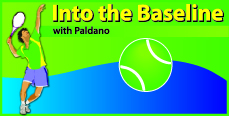How to ‘earn’ tennis skills
View(s):Starting to play Tennis is an irresistible temptation for most. Worldwide, millions get to the starting block which includes junior and adult beginners. What happens between the start and the finishing line and why is a mystery. Too few, in fact very few cross the finishing line to become a player. Attitude and pursuit need a little adjustment to reach the finishing line. First step in Tennis is to succeed in playing the game. If a beginner places achieving champion status, as the priority, then the cart is in front of the horse. It is a ‘no-go’ situation to cross the finishing line.
In Tennis, some challenges are known; some unknown; some specific to individuals and situations; and some are out of one’s control. To increase the chances of it is necessary to know ‘what is success.’
Skills of Ganguly and Sehwag
A reputed writer in a popular monthly magazine editorial said the following about two cricketers, “Ganguly has skills by the tons and courage by the teaspoon and Sehwag has courage by the tons and skills in tiny pails”. At that time both were in the Indian Team. I do not recall in what context it was told but it was a comment of a canny observer. It hints at two men in world elite cricket scene not delivering adequately.
In the entire development phase, performance and delivery must be linked. If not Ganguly-Sehwag situation will surface. In every higher step of competition ‘delivery’ will become more and more challenging. Development is a culture.
Performance culture
In this light, what is the target of development? A ‘culture to Performance’ is the answer. Without this, one would be a poor delivery man in game making and in competition. If this is understood, at each level, development will fall within the comfort zone of the player. What more, it will act as a spring board for the next level of development. This is the source of motivation and discipline for sportsmen. It is the comfort zone a player experiences.
If performance and delivery are a product of discipline, dedication, sacrifice, labour, courage, skills only, do you think a child or an adult would want to take to sport? The answer is no! Such a pursuit has no fun and provides a poor learning curve. The ‘fun’ element creates the comfort zones which we like to experience repeatedly. The performance culture makes us ‘comfortable’ to learn.
Early years of development
Tennis is not a game of a single chance, which is very much so in Cricket. The first ball can take the batsman back to the pavilion, not in Tennis. This being so, a performing culture is needed to adopt and perform under ever changing situations. As a late specialization sport, tennis does not expect champions at 17. Boris Becker won Wimbledon at 17. In sport history, Becker’s feat is a one-off and not the norm. Early years of tennis are to develop the attributes of ‘performance culture’. If you deviate from this for a quick fix, you may have tons of courage but teaspoons of skills. Skills mature slowly with age and body development. All quick fixes are guaranteed to back-fire. Accelerated body development stunts players in many vital areas and restricts tactical play. I recommend the age related development which is lasting, not harmful, fun, versatile and tactical.
Middle years of development
It is a ‘tight rope walk’. How to keep the stress level down in this situation? Performance culture can make this a cake-walk. Agassi an American player in the professional circuit played 870 matches and lost 240. Most of those losses were in the middle development period. The middle development is a roller coaster ride which will teach you to be more resilient to challenges. This is the purpose of middle development. When it is fun, the stress level drops to develop a game to suit the player.
The main aim of middle development is to achieve game making ability. To get up after being love-40 down time and again, is fostering performance culture. To win from being down match points, is performance culture. In this you will lose as many times as you win but stay and play again; this is a culture not given but earned then soon the odds will turn in your favour.
Professionalism, the final frontier
New names in the Grand Slams, new names in the top 200 of the world, are ones who have come through the middle development. They are ones who succeeded in acquiring the culture to perform. “This is not for everyone” are the words of Indian tennis celebrity Vijay Amritraj. This is very true. Today, to achieve this, you must be a 6 footer, serve at 130 MPH with 80 per cent consistency, have two major weapons, be an all-court-player and be able to perform up to 4 hours with nerves of steel and muscles of a pouncing cat. With that skill list you will also need courage by the tons.
These requirements show what the finishing line of Tennis is made of. Professionalism is not a ‘hop-in’ process. With rewards of being a dollar millionaire at 25 many are coming into Tennis. If your development is not culture based like that of Sampras, Federer, Steffi Graf, Lindsay Davenport, Justine Henin, Li Na and Kim Clijsters you will be home bound very soon.
Money is not the only reward of tennis. Club Players, playing just for fun and for good health are also crossing the finishing line. Competition life span is very short so crossing the finishing line means, tennis is for life. One doctor in Colombo played tennis till 94! That is better than a Wimbledon title. Play to cross the finish line and you are a winner! —
George Paldano was an international player; Accredited coach of Germany, ITF and USPTR. National, Davis Cup and Fed Cup Coach. – –georgepaldano@yahoo.com-
Follow @timesonlinelk
comments powered by Disqus


